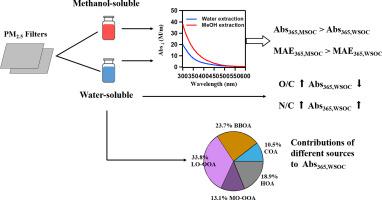当前位置:
X-MOL 学术
›
Atmos. Res.
›
论文详情
Our official English website, www.x-mol.net, welcomes your
feedback! (Note: you will need to create a separate account there.)
Brown carbon in atmospheric fine particles in Yangzhou, China: Light absorption properties and source apportionment
Atmospheric Research ( IF 4.5 ) Pub Date : 2020-11-01 , DOI: 10.1016/j.atmosres.2020.105028 Yanfang Chen , Xinchun Xie , Zhan Shi , Yilin Li , Xinyu Gai , Junfeng Wang , Haiwei Li , Yun Wu , Xiuyong Zhao , Mindong Chen , Xinlei Ge
Atmospheric Research ( IF 4.5 ) Pub Date : 2020-11-01 , DOI: 10.1016/j.atmosres.2020.105028 Yanfang Chen , Xinchun Xie , Zhan Shi , Yilin Li , Xinyu Gai , Junfeng Wang , Haiwei Li , Yun Wu , Xiuyong Zhao , Mindong Chen , Xinlei Ge

|
Abstract Light absorbing organic carbon, a.k.a., brown carbon (BrC) is an important contributor to air quality deterioration and global radiative forcing. This work studied optical, chemical properties and sources of BrC in fine particles (PM2.5) collected in Yangzhou, China. The light absorption coefficient at 365 nm of methanol-soluble organics (Abs365,MSOC) and water-soluble organics (Abs365,WSOC) were 13.50 ± 7.03 M/m and 6.08 ± 4.30 M/m, respectively. Mass absorption efficiency at 365 nm (MAE365) of methanol-soluble BrC (1.12 ± 0.35 m2/g C) was also higher than water-soluble BrC (0.75 ± 0.29 m2/g C). For water-soluble BrC, both Abs365 and MAE365 generally decreased with increases of its oxygen-to‑carbon (O/C) ratios and oxidation states (OSc), indicative of photo-bleaching upon chemical ageing. Positive responses of Abs365,WSOC and MAE365,WSOC to nitrogen-to‑carbon (N/C) ratios and water-soluble organic nitrogen (ON) contents reveal that ON species are important BrC chromophores. A multiple linear regression model was applied to apportion Abs365,WSOC to contributions of different factors resolved from positive matrix factorization on water-soluble organic aerosols (OA), and obtained MAE365 values of different OA factors. Overall, primary OA sources including traffic (18.9%), biomass burning (23.7%), and cooking-related OA (10.5%) together dominated the Abs365,WSOC despite their total mass contribution was only about one third (31.9%). The largest single contributor of Abs365,WSOC, however, was the less-oxidized secondary OA (33.8%); the more-oxidized secondary OA factor dominated water-soluble OA mass (50.8%), yet its light absorptivity was the weakest and contributed only 13.1% of Abs365,WSOC.
更新日期:2020-11-01










































 京公网安备 11010802027423号
京公网安备 11010802027423号